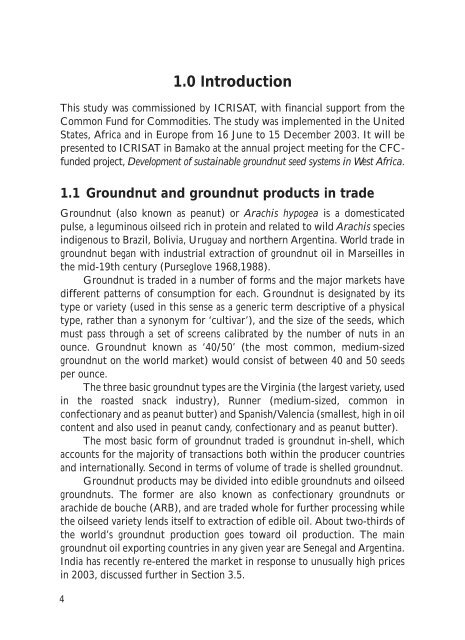Market Prospects for Groundnut in West Africa COMMON FUND ...
Market Prospects for Groundnut in West Africa COMMON FUND ...
Market Prospects for Groundnut in West Africa COMMON FUND ...
You also want an ePaper? Increase the reach of your titles
YUMPU automatically turns print PDFs into web optimized ePapers that Google loves.
4<br />
1.0 Introduction<br />
This study was commissioned by ICRISAT, with f<strong>in</strong>ancial support from the<br />
Common Fund <strong>for</strong> Commodities. The study was implemented <strong>in</strong> the United<br />
States, <strong>Africa</strong> and <strong>in</strong> Europe from 16 June to 15 December 2003. It will be<br />
presented to ICRISAT <strong>in</strong> Bamako at the annual project meet<strong>in</strong>g <strong>for</strong> the CFCfunded<br />
project, Development of susta<strong>in</strong>able groundnut seed systems <strong>in</strong> <strong>West</strong> <strong>Africa</strong>.<br />
1.1 <strong>Groundnut</strong> and groundnut products <strong>in</strong> trade<br />
<strong>Groundnut</strong> (also known as peanut) or Arachis hypogea is a domesticated<br />
pulse, a legum<strong>in</strong>ous oilseed rich <strong>in</strong> prote<strong>in</strong> and related to wild Arachis species<br />
<strong>in</strong>digenous to Brazil, Bolivia, Uruguay and northern Argent<strong>in</strong>a. World trade <strong>in</strong><br />
groundnut began with <strong>in</strong>dustrial extraction of groundnut oil <strong>in</strong> Marseilles <strong>in</strong><br />
the mid-19th century (Purseglove 1968,1988).<br />
<strong>Groundnut</strong> is traded <strong>in</strong> a number of <strong>for</strong>ms and the major markets have<br />
different patterns of consumption <strong>for</strong> each. <strong>Groundnut</strong> is designated by its<br />
type or variety (used <strong>in</strong> this sense as a generic term descriptive of a physical<br />
type, rather than a synonym <strong>for</strong> ‘cultivar’), and the size of the seeds, which<br />
must pass through a set of screens calibrated by the number of nuts <strong>in</strong> an<br />
ounce. <strong>Groundnut</strong> known as ‘40/50’ (the most common, medium-sized<br />
groundnut on the world market) would consist of between 40 and 50 seeds<br />
per ounce.<br />
The three basic groundnut types are the Virg<strong>in</strong>ia (the largest variety, used<br />
<strong>in</strong> the roasted snack <strong>in</strong>dustry), Runner (medium-sized, common <strong>in</strong><br />
confectionary and as peanut butter) and Spanish/Valencia (smallest, high <strong>in</strong> oil<br />
content and also used <strong>in</strong> peanut candy, confectionary and as peanut butter).<br />
The most basic <strong>for</strong>m of groundnut traded is groundnut <strong>in</strong>-shell, which<br />
accounts <strong>for</strong> the majority of transactions both with<strong>in</strong> the producer countries<br />
and <strong>in</strong>ternationally. Second <strong>in</strong> terms of volume of trade is shelled groundnut.<br />
<strong>Groundnut</strong> products may be divided <strong>in</strong>to edible groundnuts and oilseed<br />
groundnuts. The <strong>for</strong>mer are also known as confectionary groundnuts or<br />
arachide de bouche (ARB), and are traded whole <strong>for</strong> further process<strong>in</strong>g while<br />
the oilseed variety lends itself to extraction of edible oil. About two-thirds of<br />
the world’s groundnut production goes toward oil production. The ma<strong>in</strong><br />
groundnut oil export<strong>in</strong>g countries <strong>in</strong> any given year are Senegal and Argent<strong>in</strong>a.<br />
India has recently re-entered the market <strong>in</strong> response to unusually high prices<br />
<strong>in</strong> 2003, discussed further <strong>in</strong> Section 3.5.

















